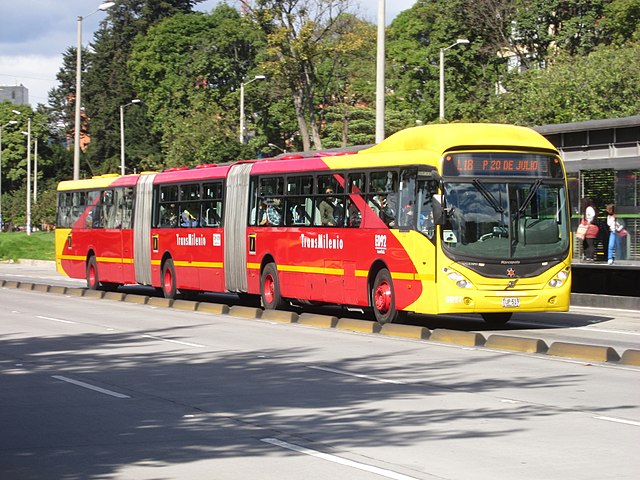The New York Times reviewed (non-paywall version) the ground-breaking bus-rapid transit system in Bogotá Columbia 23 years after it opened. The TransMilenio bus system first opened in December 2000 under fiscally conservative mayor Enrique Peñalosa and each route-mile is capable of moving more people per hour than New York City subways.
A high-capacity TransMilenio bus. Photo by Felipe Restrepo Acosta.
The system almost immediately doubled transit ridership, partly because the rapid buses were much faster than the buses they replaced but also because Bogota has a lot of low-income people who don’t own cars whose mobility was greatly enhanced by faster transit. Columbia had well under 200 motor vehicles per thousand people in 2000 (compared with more than 800 in the U.S.) and even today Columbia has fewer than 300 vehicles per thousand (compared with more than 900 in the U.S.). Whatever the reason, the rapid bus system carries up to 2 million riders a day, which is more than some U.S. light-rail lines carry in a year.
TransMilenio’s success led many other cities to install bus-rapid transit systems, though few were as fast and none had as high a capacity as Bogotá’s. Most BRT systems in the U.S. are slow (all but two in the National Transit Database averaged less than 15 mph in 2022) and of moderate capacity, plus auto ownership rates here are much higher.
Unfortunately, Peñalosa’s successors didn’t have his vision for the transit system. Partly they suffered from the “not-invented by my party” syndrome in which any idea promoted by one political party has to be opposed by other parties. Partly, they wanted to put their name on their own grandiose projects rather than be seen as someone who was just finishing a project started by a previous mayor.
Whatever the reason, Peñalosa’s original vision of 241 miles of rapid bus routes was never expanded beyond 71 miles and bus fleets weren’t replaced as they wore out. Buses were overcrowded and the city’s car-owning elites complained that dedicated bus lanes were a waste of good road space. That would be a valid complaint in most of the United States, where transit agencies typically run four or five nearly empty buses per hour, but not in Bogotá where a bus lane may support 280 buses per hour and carry 41,000 people per hour, far more than any highway or, for that matter, any rail line in the U.S. if not the world.
Now the city is building its first rail transit line, not because rails are better but because they are more expensive and so fares will be higher. That’s so the city’s elites won’t have to sully themselves by rubbing shoulders with people who can afford the lower fares of the rapid buses.
The elites “would never be caught dead riding TransMilenio,” Peñalosa told the Times. “Now they’re on board for building a subway — even though I assure you that 99.9 percent of them have no intention of ever using it.”
Of course, building rail at taxpayer expense will generate far more profits for construction companies than rapid buses, so they have become the constituency for rail transit. “The heavy-rail metros have big lobbies behind them — German, French, Chinese and Japanese,” says BRT supporter Walter Hook.
Transit in Columbia, as in the United States, has become a political football. Ironically, the left opposes TransMilenio because, they say, it displaced colectivos — privately owned microbuses that carried people on demand — with a “corporatized” system (though it is publicly owned). When that happened in Santiago, Chilé, transit ridership declined, but when it happened in Bogotá, ridership doubled, but for ideologues it is the principles, not the results, that count. As a result, says Hook, rapid buses, as successful and economical as they are, “have no clear political constituency.”
So a great idea is forgotten due to politics. This is one more example of why transportation, whether publicly or privately owned, should be paid for out of user fees. Where taxpayer-funded agencies hav incentives to generate political support by adopting costly obsolete technologies, managers funded out of user fees would have incentives to find innovations that will move more people at lower costs.









What kills buses? Exactly…….
Buses were overcrowded and the city’s car-owning elites complained that dedicated bus lanes were a waste of good road space. ”
It’s called “Bus Stigmatization”
Ocean liners and trains have Class seating…….
People forget Ocean liners didn’t make money carrying 1st class passengers, they made money carrying Mail Hence name (RMS Royal Mail Steamer), 3rd class immigrants 2000 at a time to new world.
If articulated buses has class seating with 20 1st class and 40 rearward standard economy seats. but since urban transit buses aren’t pre-loaded, this is not consequential means.
It’s the perception of luxury.
Anyone who ever saw Titanic, can google the menu they offered. 1st class passengers ate…
– Chateau potatoes: we call today, rosemary roasted potatoes
– Roast Squab and cress: aka PIGEON meat.
– Puffed rice (Rice crispies)
Politicians enjoy cutting ribbons, what they hate is closing shop.
Point is Rail’s history in South America is largely tepid.
In colonial era, rail freight moved tons of goods, fruit, sugar from inner regions to ports. But out of context passenger rail thou very prolific in Mega cities such as Sao Paulo; it has with it it’s problems.
– South America’s Humid climate, seasonal storms, and intense Equatorial sun wreak havoc on infrastructure, hence why Sao Paulo metro is underground, however expense of digging thru biggest cities on Earth peaked any new development.
– it’s climate is a easy growth medium. Engineers at Panama Canal, routinely have to beat back agaisnt jungle regenerating and sediment in the Canal. Transit infrastructure also subject to these forces.